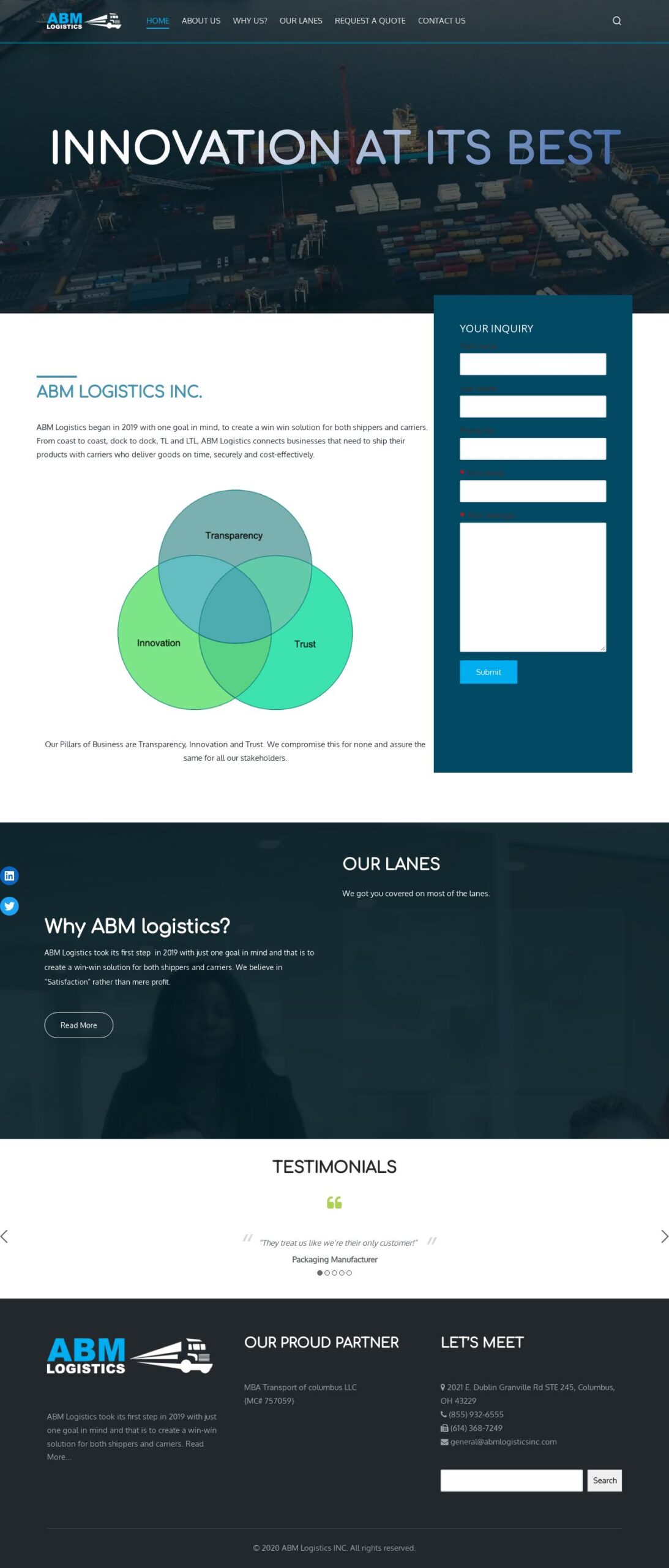Creating a website for a ABM LOGISTICS INC USA( . Dublin Granville Rd STE 245, Columbus, OH 43229) company. It can be a great way to showcase services, attract potential clients, and provide essential information to existing customers. Here are some key elements you should consider when developing a website for a logistic company:

- Homepage: Create an engaging homepage that introduces your company and highlights your core services. Use high-quality images and concise, compelling text to grab visitors’ attention and encourage them to explore further.
- About Us: Provide a detailed overview of your company’s history, mission, and values. Include information about your team, expertise, and any certifications or awards you have received.
- Services: Create a dedicated section to outline the range of logistic services you offer. Divide them into categories such as transportation, warehousing, inventory management, supply chain optimization, and customs clearance. Include descriptions, benefits, and any specific industries you specialize in.
- Track and Trace: Incorporate a user-friendly track and trace system that allows clients to monitor the status of their shipments in real-time. Provide a login portal for customers to access personalized tracking information.
- Service Areas: Clearly define the geographical areas you operate in, including both domestic and international locations. Include interactive maps or dropdown menus to help users find information specific to their region.
- Request a Quote: Include a form or a dedicated page where potential clients can request a quote for your services. Gather essential details such as the type of shipment, origin, destination, dimensions, and any specific requirements.
- Testimonials and Case Studies: Showcase client testimonials and success stories to build trust and demonstrate your company’s capabilities. Highlight any challenging logistics projects you have successfully executed.
- Resources: Provide helpful resources such as whitepapers, e-books, or blog articles related to logistics, supply chain management, and industry trends. This positions your company as an authoritative source of information.
- Contact Information: Ensure your contact details are prominently displayed on every page. Include a contact form, phone number, email address, and links to your social media profiles. Consider adding a live chat feature for real-time customer support.
- Mobile-Friendly Design: Optimize your website for mobile devices since many people browse the internet on their smartphones and tablets. Ensure your website is responsive and provides a seamless experience across different screen sizes.
- Security: Implement necessary security measures to protect customer data and ensure secure online transactions. Use SSL certificates to enable encrypted communication and display trust seals to boost confidence.
- Visual Design: Choose a professional, clean, and modern design that aligns with your brand identity. Utilize your company’s colors, logo, and fonts consistently throughout the website.
- SEO Optimization: Optimize your website for search engines by incorporating relevant keywords in your content, meta tags, headings, and image alt text. This helps improve your website’s visibility in search engine results.
- Social Media Integration: Integrate social media buttons and links to encourage visitors to connect with you on platforms like Facebook, Twitter, LinkedIn, and Instagram. This allows for increased engagement and wider reach.
- Analytics and Tracking: Set up website analytics tools such as Google Analytics to track visitor behavior, measure website performance, and gain insights for ongoing improvements.
Remember to regularly update your website with fresh content, news, and updates to keep it relevant and engaging. A well-designed and informative website can significantly contribute to the success of your logistic company by attracting new clients and enhancing customer satisfaction.
